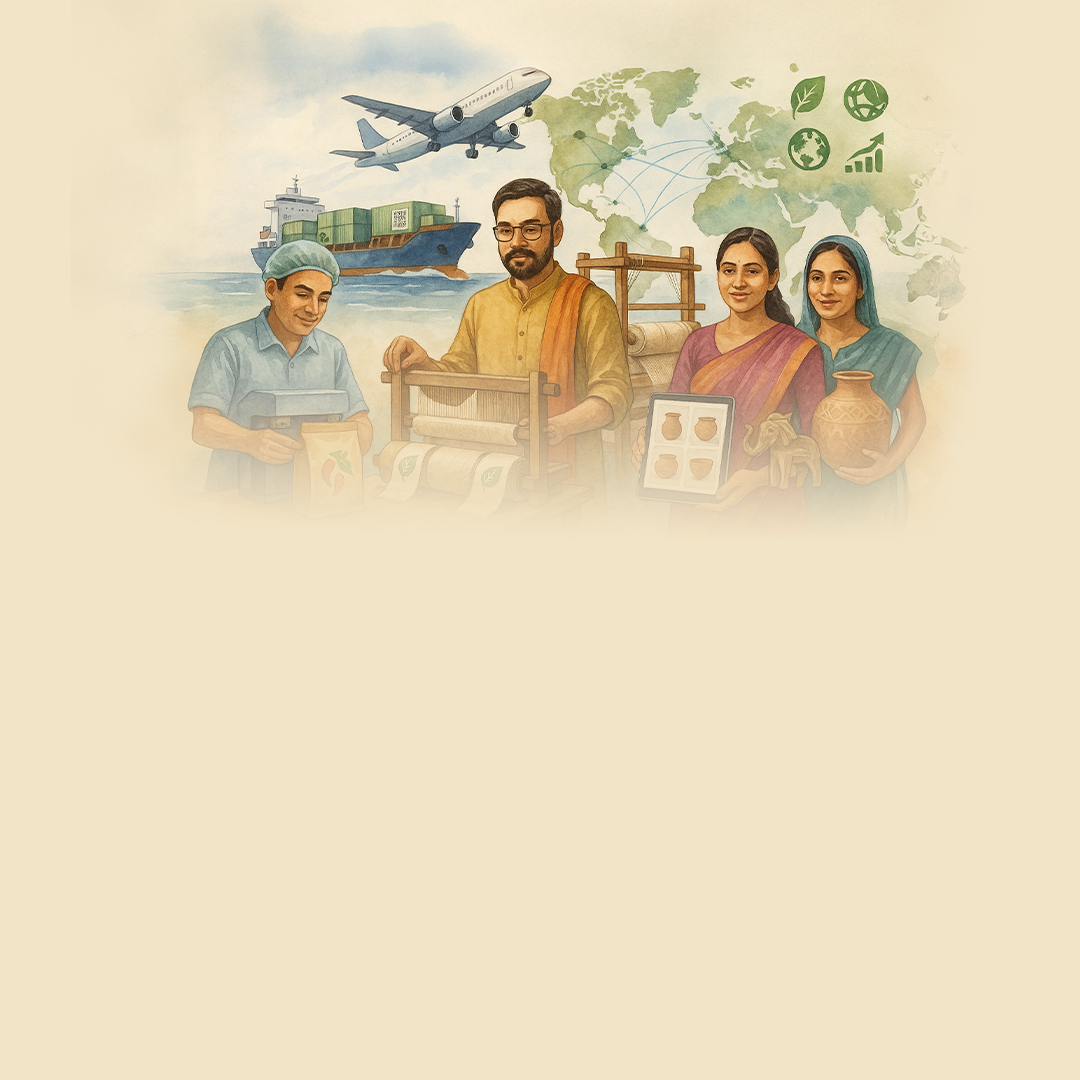6 Actionable Strategies for MSMEs to Tap into the ₹12.39 lakh crore Export Value Boom
- The export value from MSMEs has tripled from ₹3.95 lakh crore in FY2021 to ₹12.39 lakh crore in FY2025, with the number of exporting MSMEs rising to 1.73 lakh.
- India’s export basket has diversified to include value-added, artisanal, and manufactured goods across textiles, food processing, handicrafts, engineering goods, and IT services.
- Digital platforms like ONDC, GeM “Aabhar,” and global B2B marketplaces have made it easier for small businesses to reach international buyers
- Emerging niches like sustainable textiles, functional foods, and GI-tagged art offer new export opportunities for MSMEs that innovate early and adapt to consumer preferences abroad.
- To fully leverage the export boom, MSMEs must act across six areas: focus on quality, boost digital visibility, get certified, use available schemes, align with sector trends, and build reliable logistics.
As of May 2024, MSMEs contributed 45.79% of the country’s total merchandise exports. In just four years, the export value from these enterprises has tripled: from ₹3.95 lakh crore in FY2021 to ₹12.39 lakh crore in FY2025. The number of exporting MSMEs has also increased more than three times, rising from around 52,000 to 1.73 lakh registered exporters.
This shift proves the exponential growth of India’s export basket, from mostly traditional goods to a mix of value-added, artisanal, and manufactured products in textiles, processed foods, handicrafts, engineering goods, and IT services. The credit for this growth largely goes to digital platforms that are enabling MSMEs to reach global buyers and stay competitive. Besides, new-age tools are reducing the need for traditional intermediaries and opening direct access to international markets. For instance:
- Open Network for Digital Commerce (ONDC): Enables MSMEs to list their products on a unified e-commerce ecosystem that reaches both domestic and global customers. It reduces dependency on dominant platforms and offers better discovery.
- GeM “Aabhar” Collection: Helps handloom weavers, artisans, and tribal producers showcase their work to institutional buyers, boosting both domestic procurement and export visibility.
- Udyam Portal: Registered MSMEs gain access to trade finance schemes, digital onboarding support, and integration with e-commerce platforms.
- Global B2B marketplaces: Digital-first MSMEs are also increasingly using these platforms to connect with overseas clients. Verified WhatsApp Business profiles, business websites, and digital catalogs further enhance trust and visibility.
While the factors mentioned above are driving growth, MSMEs are becoming more well-positioned to serve new markets due to the shifting global demand.
Global Trends Powering the Rise of Indian Exports
India’s growing export is being fueled by several global economic and consumer shifts—each creating new demand patterns that favor Indian products. For MSMEs, understanding these shifts is crucial to aligning their offerings and effectively tapping into the export wave.
1. Diversification of Supply Chains (China+1 Strategy)
Global importers are reducing their overreliance on China for manufacturing, particularly after the pandemic led to supply disruptions. This has created fresh opportunities for countries like India to position themselves as alternative suppliers. Indian engineering goods, auto components, electronics, and textiles are seeing increased orders as part of this strategic sourcing shift.
2. Rise of Health and Wellness Consumption
From the US to Europe, consumers are actively seeking healthier food options, natural ingredients, and herbal supplements. This trend has led to an increased demand for Indian spices, herbal teas, Ayurvedic products, millets, and dairy-based exports—all areas where Indian MSMEs possess production capabilities and traditional knowledge.
3. Growing Demand for Ethical and Sustainable Products
Buyers across Europe, North America, and even parts of Asia are prioritizing eco-friendly and ethically sourced goods. Indian handicrafts, GI-tagged textiles, bamboo products, and natural fabrics are aligning well with these values. MSMEs involved in traditional crafts or organic production can especially benefit from this shift.
4. Growth in E-Commerce and Digital Discovery
The explosion of digital marketplaces has made it easier for small, specialized businesses from Tier-2 and Tier-3 cities to be discovered by international buyers. E-commerce platforms, are removing traditional entry barriers, enabling MSMEs to serve global niches with the right packaging, pricing, and logistics support.
5. Demand for Convenience and Packaged Foods
In another, somewhat contradictory, shift to the health-focused trend, global consumers are increasingly opting for ready-to-eat, pre-cooked, or processed foods driven by busy lifestyles. Many of these products are also exported to countries that cannot grow certain produce locally, making India a key supplier for such demand. India’s processed food sector, which ranges from frozen meals to snack items, is equipped to tap into this demand, particularly with the rising export readiness among MSMEs supported by the Agricultural and Processed Food Products Export Development Authority (APEDA) and improvements in cold-chain infrastructure.
Backed by these favorable global conditions, India’s export portfolio has continued to diversify.
The table below captures the top 10 export categories by value in FY2024–25, reflecting a blend of traditional strength and emerging demand. From sourcing and manufacturing to assembly, packaging, and first-mile logistics, small enterprises power entire value chains across high-performing sectors. Their localized expertise, adaptability, and sheer volume make them indispensable to both traditional exports and emerging categories. Several industries already demonstrate how deeply integrated MSMEs are into the export supply chain:
| Rank | Product Category | Value (USD Billion) | Growth % (FY24-25 vs FY23-24) |
| 1 | Engineering Goods (Light Engineering & Extrusion) | 116.67 | 6.74% |
| 2 | Petroleum Products | 60.07 | -11.86% |
| 3 | Electronic Goods | 38.58 | 32.47% |
| 4 | Drugs and Pharmaceuticals | 30.38 | 9.39% |
| 5 | Gems and Jewellery | 29.8 | 10.62% |
| 6 | Organic and Inorganic Chemicals | 28.63 | -2.78% |
| 7 | Ready-made garments of all textiles | 15.99 | 10.03% |
| 8 | Rice | 12.47 | 19.73% |
| 9 | Cotton Yarn/Fabs./Madeups, Handloom | 12.04 | 6.65% (April 2024) |
| 10 | Plastic And Linoleum | 8.92 | 10.23% |
Source: Ministry of Commerce and Industry, as of FY2024-25
- Light Engineering & Extrusion: In FY2024–25, India exported $116.67 billion worth of engineering goods, such as industrial fasteners, automotive components, precision machine parts, aluminum profiles, pipes and tubes, and fabricated metal structures, making it the country’s top merchandise export category. MSMEs in Coimbatore, Pune, and Ludhiana manufacture fasteners, automotive parts, and aluminum profiles for markets such as the US, EU, and ASEAN.
- Food Processing: India exported $7.2B in marine products and saw processed fruits & vegetables double from $588M to $1.16B over five years. Cold chain processors and ODOP-linked MSMEs are key players in this sector.
- Plastic & Moulded Goods: From Gujarat to NCR, small units make packaging, auto parts, and consumer plastics. FY25 exports touched $8.92 billion with double-digit growth.
- Apparel and Handicrafts: India exported $21.36 billion in garments, cotton, carpets, and handicrafts. MSMEs across urban powerlooms and rural weaving clusters are major contributors.
- Pharma & Healthcare: Small formulation units, surgical goods manufacturers, and packaging firms contribute to the $30.38 billion pharma export segment.
- Furniture & Woodwork: MSMEs in Saharanpur, Jodhpur, and Kerala are exporting handcrafted furniture, supported by schemes like PM Vishwakarma.
- Gensets & Material Handling: Exported to Africa and Southeast Asia, many of these products are assembled or sourced from MSMEs supplying components to larger OEMs.
Beyond these existing sectors, new export trends are also taking shape, and MSMEs that spot and act on them early could gain a competitive edge. These include:
- Functional foods: Millets, fermented drinks, and RTE health snacks are gaining traction globally.
- Sustainable textiles: Banana fiber, cork, and recycled yarns are attracting ethical buyers.
- Niche digital platforms: MSMEs can reach global buyers via platforms like TradeIndia Global, ONDC, and Amazon Global Selling.
- GI-tagged art: ODOP crafts and handmade items promoted through digital showcases are gaining visibility in the US and Europe.
In a bid to increase revenues from the export boom, MSMEs can take these six proactive steps and align themselves with global demand:
- Focus on Quality
MSMEs must upgrade their manufacturing set-ups and invest in better raw materials, to reduce defective products. . Upgrading production infrastructure by opting for Machinery Loans from RBI-registered NBFCs like Protium or opting for schemes like CLCSS (Credit Linked Capital Subsidy Scheme), can allow manufacturers to conserve on their working capital and utilise it for more important purposes such as improving export readiness. Additionally, availing support under ZED Certification (Zero Defect Zero Effect) ensures that quality also meets sustainability benchmarks—often a prerequisite for international buyers. - Digital Visibility
Having a website or verified business profile has now become essential. MSMEs should use e-catalogs, ONDC listings, and global B2B platforms to improve discoverability. Support is available under the Digital MSME Scheme, and integration through Udyam allows linkage to trade portals, payment systems, and e-marketplaces. Digital visibility also builds buyer trust, especially when combined with trackable logistics and online testimonials. - Get Certified
From FSSAI in food exports to CE in electronics and ISO in manufacturing, global buyers expect third-party validation. These certifications help MSMEs comply with technical regulations, access high-value markets, and reduce the chances of shipment rejection. The MAI can partly fund certification, lab testing, and participation in training or workshops required to become export-ready. - Maximize Existing Support System
Schemes like RoDTEP, MAI, TIES, and PM Vishwakarma Yojana are designed to reduce entry costs and enhance export capabilities. However, many MSMEs remain unaware or hesitant to apply. Local District Industries Centers (DICs), Export Promotion Councils, and MSME Development Institutes provide support to navigate paperwork and eligibility requirements. Formalization via Udyam Registration is often the gateway to unlocking these policy benefits. - Align Products to Sector Trends
Export demand is shifting. Food MSMEs should invest in tamper-proof, longer shelf-life packaging, a step often supported under the Agri Export Policy or APEDA guidelines. Textile MSMEs can explore biodegradable dyes and recycled yarns to meet the growing demand for eco-conscious products. Artisans can leverage GI tagging, ODOP e-catalogs, and GeM’s “Aabhar” to amplify reach and pricing power, especially in niche international markets. - Build Reliable Logistics
Good products need good delivery. MSMEs must partner with freight forwarders, cold-chain providers, and warehousing networks to ensure timely and safe delivery. The TIES helps develop export infrastructure, including dry ports, testing labs, and container freight stations. Integrating logistics planning early also enables MSMEs to provide realistic delivery timelines—essential for establishing long-term buyer relationships.
To support MSME exporters, India’s policy ecosystem is steadily evolving to support export-ready MSMEs through targeted financial incentives, infrastructure development, and growing market access. This will be beneficial for those Enterprises that invest in operational upgrades, formalize their businesses, and actively leverage available government schemes that capture emerging global opportunities. Furthermore, by aligning with sector trends and building robust supply chain capabilities, MSMEs can be an integral part of the ₹12.39 lakh crore export boom, thereby expanding their presence in international markets.

